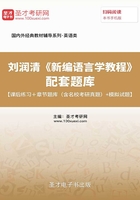
第6章 语用学
1.Define the following terms briefly.
pragmatics
deixis
reference
anaphora
presupposition
speech Act Theory
indirect speech act
the Cooperative Principle
the Politeness Principle
conversational implicature
Key:
·Pragmatics: A branch of linguistics that study the meaning of language in use. It studies speakers’ intended meaning, or even the "invisible" meaning, that is, how hearers recognize what is meant even when it isn’t actually said or written.
·Deixis: In all languages there are many words and expressions whose reference depend entirely on the situational context of the utterance and can only be understood in light of these circumstances. This aspect of pragmatics is called deixis, which means “pointing” via language.
·Reference: In Pragmatics, the act by which a speaker or writer uses language to enable a hearer or reader to identify something is called reference.
·Anaphora: Anaphora refers to the process where a word or phrase refers back to another word or phrase which was used earlier in a text or conversation.
·Presupposition: A presupposition is an implicit assumption made by the speaker or writer about the world, which is required to make an utterance meaningful and appropriate.
·Speech Act Theory: Speech act theory was proposed by J. L. Austin and has been developed by J. R. Searle. Basically, they believe that language is not only used to inform or to describe things, it is often used to “do things”, and to perform acts.
·Indirect speech act: When an utterance is used to make a command/request indirectly and implicitly, the utterance is functioning as an indirect speech act.
·The Cooperative Principle: In actual communication, the speaker usually means a lot more than what is said. H. P. Grice believes that there must be some mechanism governing the production and comprehension of utterances. He suggests that there is a set of assumptions guiding the conduct of conversation. This is what he calls the Cooperative Principle (CP), which has four maxims: the maxim of quality, quantity, relation and manner.
·The Politeness Principle: The Politeness Principle (PP) is another principle which applies to conversation in addition to the CP. It can satisfactorily explain exceptions to and apparent deviations from the CP. The PP contains six maxims: the maxim of tact, generosity, approbation, modesty, agreement and sympathy.
·Conversational implicature: Conversational implicature is a kind of extra meaning that is not literally contained in the utterance.
2.What are the deictic expressions in the following utterance?
I’m busy now so you can’t do that here. Come back tomorrow.
Key: Deictic expressions: I, now, you, that, here, tomorrow.
3.What are the anaphoric expressions in the following utterance?
Dr. Dang gave Jane some medicine after she asked him for it.
Key: Anaphoric expressions: She, him, it.
4.What is one obvious presupposition of a speaker who says:
(1) Where did he buy the beer?
(2) Your watch is broken.
(3) We regret buying that car.
Key: (1) He bought some beer.
(2) You have a watch.
(3) We already bought that car.
5.Someone stands between you and the TV set you were watching, so you decide to say one of the following. Identify which would be direct and which would be indirect speech acts.
(1) Move!
(2) You’re in the way.
(3) Could you sit down?
(4) I can’t see anything.
(5) Please get out of the way.
Key: Direct speech act: (1), (5)
Indirect speech act: (2), (3), (4)
6.What are the four maxims of the Cooperative Principle?
Key: The Cooperative Principle(CP) contains four maxims:
The Maxim of Quantity
Make your contribution as informative as is required (for the current purposes of the exchange).
Do not make your contribution more informative than is required.
The Maxim of Quality
Try to make your contribution one that is true.
Do not say what you believe to be false.
Do not say that for which you lack adequate evidence.
The Maxim of Relation: Be relevant.
The Maxim of Manner:
Be perspicuous.
Avoid obscurity of expression.
Avoid ambiguity.
Be brief (avoid prolixity).
Be orderly.
7.Which maxim does this speaker seem to be particularly careful about:
Well, to be quite honest, I don’t think she is ill today.
Key: This speaker is particularly careful about the maxim of quality, because he/she said, “to be quite honest”, which means he/she does not want to say what he/she believes to be false.
8.How would you describe this short exchange in terms of the actions performed by the speakers?
Carol: Are you coming to the party tonight?
Lara: I’ve got an exam tomorrow.
Key: It is an indirect speech act. Carol invites Lara to a party, but Lara wants to decline the invitation. To be polite, she doesn’t choose a direct refusal, instead she says “I’ve got an exam tomorrow” as a reasonable excuse to decline the invitation. In this way, she minimizes the expression of impolite beliefs, thus the utterance conforms to PP. Obviously Lara breaks the maxim of relation of CP by talking about something totally irrelevant with Carol’s question. However, we can understand her meaning perfectly. Lara is conveying an indirect meaning by giving out an utterance containing a conversational implicative. Her aim is to refuse Carol’s invitation in an polite and less harsh manner.